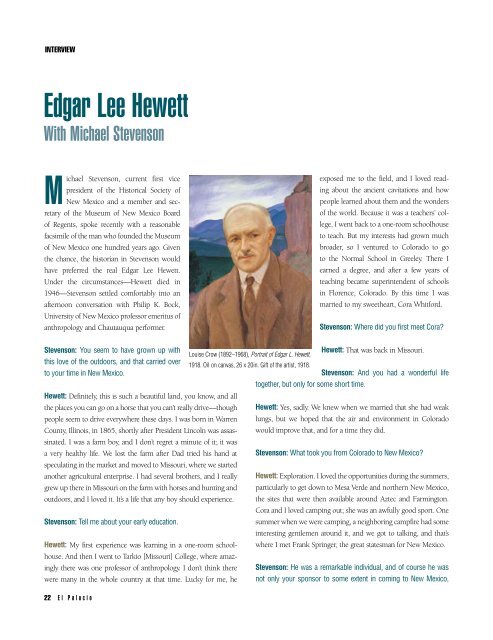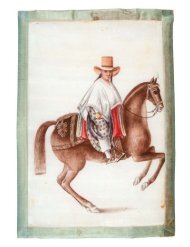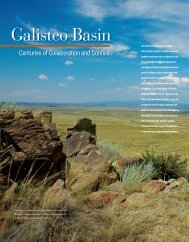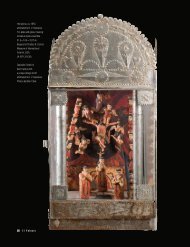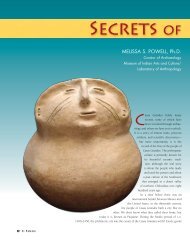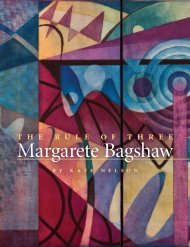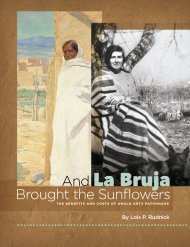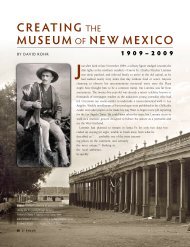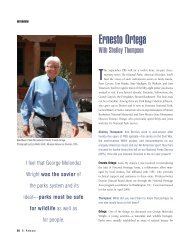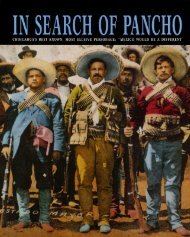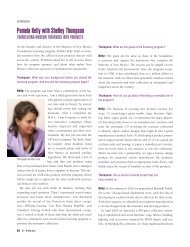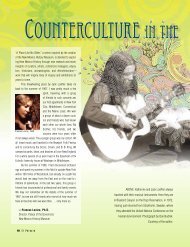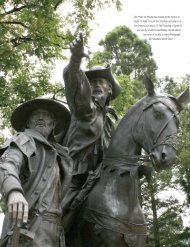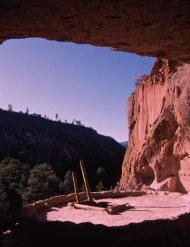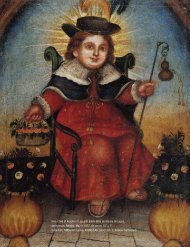Interview with Edgar Lee Hewett - El Palacio Magazine
Interview with Edgar Lee Hewett - El Palacio Magazine
Interview with Edgar Lee Hewett - El Palacio Magazine
Create successful ePaper yourself
Turn your PDF publications into a flip-book with our unique Google optimized e-Paper software.
INTERVIEW<br />
<strong>Edgar</strong> <strong>Lee</strong> <strong>Hewett</strong><br />
With Michael Stevenson<br />
Michael Stevenson, current first vice<br />
president of the Historical Society of<br />
New Mexico and a member and secretary<br />
of the Museum of New Mexico Board<br />
of Regents, spoke recently <strong>with</strong> a reasonable<br />
facsimile of the man who founded the Museum<br />
of New Mexico one hundred years ago. Given<br />
the chance, the historian in Stevenson would<br />
have preferred the real <strong>Edgar</strong> <strong>Lee</strong> <strong>Hewett</strong>.<br />
Under the circumstances—<strong>Hewett</strong> died in<br />
1946—Stevenson settled comfortably into an<br />
afternoon conversation <strong>with</strong> Philip K. Bock,<br />
University of New Mexico professor emeritus of<br />
anthropology and Chautauqua performer.<br />
exposed me to the field, and I loved reading<br />
about the ancient cavitations and how<br />
people learned about them and the wonders<br />
of the world. Because it was a teachers’ college,<br />
I went back to a one-room schoolhouse<br />
to teach. But my interests had grown much<br />
broader, so I ventured to Colorado to go<br />
to the Normal School in Greeley. There I<br />
earned a degree, and after a few years of<br />
teaching became superintendent of schools<br />
in Florence, Colorado. By this time I was<br />
married to my sweetheart, Cora Whitford.<br />
Stevenson: Where did you first meet Cora?<br />
Stevenson: You seem to have grown up <strong>with</strong><br />
this love of the outdoors, and that carried over<br />
to your time in New Mexico.<br />
Louise Crow (1892–1968), Portrait of <strong>Edgar</strong> L. <strong>Hewett</strong>,<br />
1918. Oil on canvas, 26 x 20in. Gift of the artist, 1918.<br />
<strong>Hewett</strong>: That was back in Missouri.<br />
Stevenson: And you had a wonderful life<br />
together, but only for some short time.<br />
<strong>Hewett</strong>: Definitely, this is such a beautiful land, you know, and all<br />
the places you can go on a horse that you can’t really drive—though<br />
people seem to drive everywhere these days. I was born in Warren<br />
County, Illinois, in 1865, shortly after President Lincoln was assassinated.<br />
<strong>Hewett</strong>: Yes, sadly. We knew when we married that she had weak<br />
lungs, but we hoped that the air and environment in Colorado<br />
would improve that, and for a time they did.<br />
I was a farm boy, and I don’t regret a minute of it; it was<br />
a very healthy life. We lost the farm after Dad tried his hand at Stevenson: What took you from Colorado to New Mexico?<br />
speculating in the market and moved to Missouri, where we started<br />
another agricultural enterprise. I had several brothers, and I really<br />
grew up there in Missouri on the farm <strong>with</strong> horses and hunting and<br />
outdoors, and I loved it. It’s a life that any boy should experience.<br />
<strong>Hewett</strong>: Exploration. I loved the opportunities during the summers,<br />
particularly to get down to Mesa Verde and northern New Mexico,<br />
the sites that were then available around Aztec and Farmington.<br />
Cora and I loved camping out; she was an awfully good sport. One<br />
Stevenson: Tell me about your early education.<br />
summer when we were camping, a neighboring campfire had some<br />
interesting gentlemen around it, and we got to talking, and that’s<br />
<strong>Hewett</strong>: My first experience was learning in a one-room schoolhouse.<br />
where I met Frank Springer, the great statesman for New Mexico.<br />
And then I went to Tarkio [Missouri] College, where amaz-<br />
ingly there was one professor of anthropology. I don’t think there<br />
were many in the whole country at that time. Lucky for me, he<br />
Stevenson: He was a remarkable individual, and of course he was<br />
not only your sponsor to some extent in coming to New Mexico,<br />
22 <strong>El</strong> <strong>Palacio</strong>
ut he later helped establish what is now the School for Advanced<br />
Research and the Museum of New Mexico. You’d be pleased to know<br />
that a biography by David L. Caffey about Springer was published<br />
<strong>with</strong>in the past few years, and it’s an excellent book.<br />
<strong>Hewett</strong>: He was active in state politics. He’d come out to make his<br />
fortune. He did that as part of a land grant company that was able<br />
to profit from the railroad right away, but he was very devoted to<br />
New Mexico and especially to Santa Fe.<br />
Stevenson: As I understand it now, you ended up at the Normal<br />
School in Las Vegas—now Highlands University, <strong>with</strong> a hall named<br />
for you—and you helped to establish the faculty there.<br />
<strong>Hewett</strong>: With Frank’s help I became the first president, planning the<br />
campus, hiring the faculty, and trying to institute my own philosophy<br />
of education, which was to get people out of the classroom, out<br />
of the laboratory, and into the real world, not of business, necessarily,<br />
but of seeing what the world was like.<br />
Stevenson: You were there only a few years, and I gather that the<br />
politics of the situation became difficult for you.<br />
<strong>Hewett</strong>: People would be amazed to hear this today, but at that time<br />
in New Mexico, politicians intervened in educational matters quite<br />
often. I think Governor [Miguel Antonio] Otero wanted someone<br />
else in that position, so after five years I was dismissed. Through<br />
the years I’d been back and forth to Washington, and—though<br />
not at that precise moment but later on—I was considered for a<br />
position at the Smithsonian. I had ties <strong>with</strong> the Bureau of American<br />
Ethnology and I think I could have had a position there, but that<br />
wasn’t really what I wanted to do.<br />
Stevenson: Tell me about your involvement in the politics of the<br />
Antiquities Act.<br />
<strong>Hewett</strong>: It was back in Washington after Cora died. We’d been talking<br />
about it for some time, and I had link up <strong>with</strong> Congressman<br />
John F. Lacy, from Iowa, who was very interested from his own<br />
point of view in preservation of antiquities. Together we wrote and<br />
passed the Antiquities Act of 1906, <strong>with</strong> support from President<br />
Theodore Roosevelt and other important people who saw that<br />
things were being destroyed that were worthy of preservation.<br />
Stevenson: At that time the concern was not just pothunters who<br />
would go to these ancient sites and dig up artifacts and steal them.<br />
INTERVIEW<br />
You and others also were concerned about Europeans—reputable<br />
archaeologists—coming to the Southwest and taking objects.<br />
<strong>Hewett</strong>: There was a lot here, but that doesn’t mean that the prize<br />
objects should run off to a museum in Stockholm. About that time,<br />
even our own institutions weren’t that particular. There was an<br />
exposé about an expedition from Yale that was smuggling artifacts<br />
from Yucatán. Something had to be done to protect sites.<br />
Stevenson: And of course the Antiquities Act included the ability of<br />
the president to establish national monuments, and that ultimately<br />
led to several across the West, in part to protect antiquities of these<br />
ancient sites. Was it in this period that you realized that you wanted<br />
to get some more professional credentials in archaeology, and that<br />
the University of Geneva came into the picture?<br />
<strong>Hewett</strong>: Correct. That was before Cora died. I could see that she<br />
was growing weaker, and I’d always promised I would take her to<br />
the Old World to see some great sites there. We read together about<br />
Greece and Rome and Egypt. On our trip there in about 1905—it<br />
was just after my father had died and just after I had been, let’s<br />
say, not renewed at what’s now Highlands University—Cora and I<br />
stopped in Geneva, where I talked <strong>with</strong> the archaeological faculty<br />
there and found them highly receptive to New World archaeology,<br />
even though most of their studies were classical antiquity. I was<br />
able to tell them about the work I and other people had done in<br />
the Southwest, and they said, “Well, you know, you’ll have to come<br />
here for some lectures, but we can accept a lot of your background<br />
for credit.” They also said that if I’d do my dissertation in—God<br />
help me—French, I could get a degree more easily and a lot faster<br />
than if I had to go through some snobbish Ivy League system.<br />
Stevenson: It seems that you often ran crosswise <strong>with</strong> that Eastern<br />
establishment of archaeology.<br />
<strong>Hewett</strong>: I think something is lost as well as gained when the academic<br />
scientists take over a field. The passionate amateur has a lot<br />
to offer in terms of really intense local knowledge, and sometimes<br />
academics will just come in and think they have to invent everything<br />
from scratch. But take Frank Springer, who was not only<br />
a brilliant lawyer and a genuine statesman but also a passionate<br />
amateur expert on crinoid fossils. I have a little anecdote. Frank<br />
studied these things for years and published at his own expense<br />
a great many volumes and devised a system for the classification<br />
of crinoids. One year, when he was in England, he wanted to visit<br />
the British Museum and see their collection. At first he was very<br />
<strong>El</strong> <strong>Palacio</strong> 23
INTERVIEW<br />
disappointed because he could see the section was closed. When<br />
he asked the curator why, he was told, “Well, we’re changing our<br />
whole system to the Springer classification.” He then introduced<br />
himself and of course he got to view anything he wanted.<br />
Stevenson: Also coming along was more interest in archaeology in<br />
America, which in time led to the establishment of the School for<br />
American Archaeology, which was in partnership and was sort of<br />
the mother institution for the establishment of the Museum of New<br />
Mexico. How was that worked out? How’d it happen?<br />
<strong>Hewett</strong>: In Washington, New York, and several other places, there<br />
were chapters of the Archaeological Institute of America. I was on<br />
the board of one of those chapters for a while, and it was clear that<br />
the major interest was in classical archaeology—again in getting a<br />
mummy or some Greek silver or Roman statuary rather than in<br />
the antiquities of this country. So I was able to establish the School<br />
for American Archaeology as a branch of that institute. That, along<br />
<strong>with</strong> my soon-to-be Ph.D., provided prestige and the kind of credentials<br />
that attract money. And the school, as you said, grew into<br />
the Museum of New Mexico. For a long time there was a fluid relationship,<br />
but, alas, most institutions develop jealousies, and boards<br />
want recognition and so forth.<br />
Stevenson: Establishing the museum included an agreement that<br />
SAR and MNM could use part of the Palace of the Governors,<br />
sharing the building <strong>with</strong> former Governor Bradford Prince and the<br />
Historical Society of New Mexico. How did that work?<br />
<strong>Hewett</strong>: Not well. In fact, that brings to mind another anecdote. We<br />
were developing large collections and a library—a research library<br />
for Southwestern history and archaeology. We felt that the New<br />
Mexico Historical Society, while certainly an important institution,<br />
didn’t really need all the room they had. So one night some friends<br />
of mine came in <strong>with</strong> sledgehammers and expanded the museum’s<br />
area. I don’t think we were ever forgiven.<br />
Stevenson: There must have been tension there for years, certainly<br />
until Governor Prince died in 1922, which ended that phase.<br />
<strong>Hewett</strong>: That’s also about when my Santa Fe phase ended, but for<br />
other reasons. I’m afraid that if you want to get anything , you’re<br />
going to step on somebody’s toes. I might have been more politic<br />
on a number of occasions, but I did get things done. n<br />
The conversation continues at elpalacio.org.


